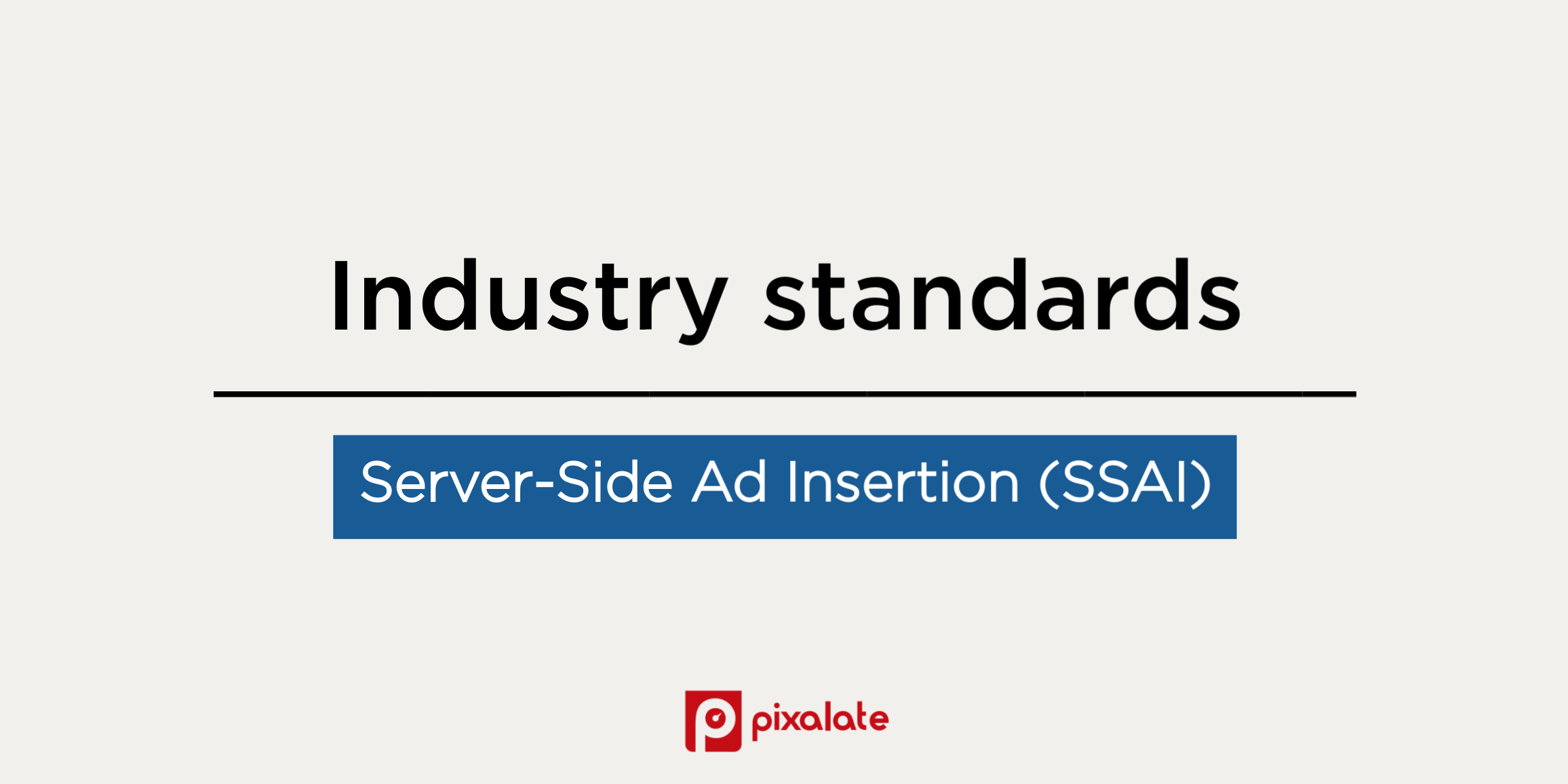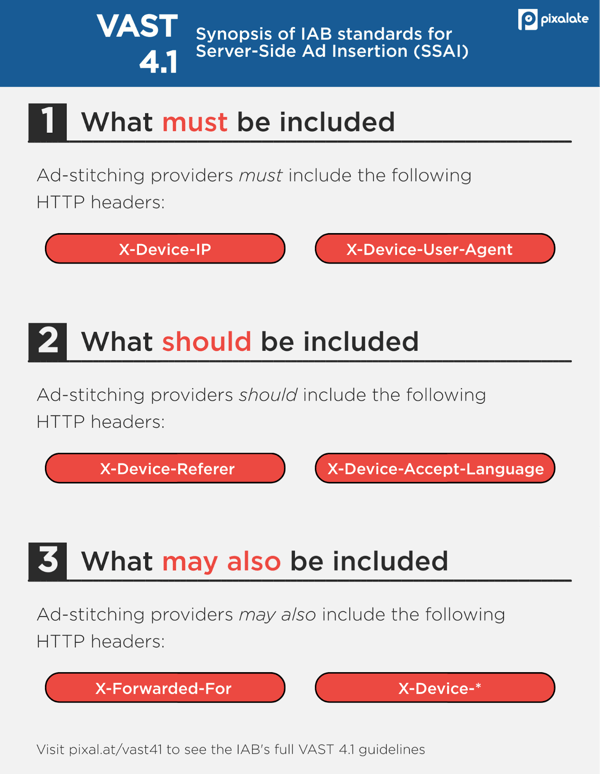
How are the industry’s governing bodies — namely the Media Rating Council (“MRC”) and the Interactive Advertising Bureau (“IAB”) — approaching server-side ad insertion (“SSAI”) measurement?
Per Pixalate, SSAI is used in 38% of programmatic OTT/CTV transactions. However, it’s prone to fraud: When SSAI is used in programmatic OTT/CTV, it’s invalid 26% of the time, as measured by Pixalate.
The IAB and MRC have collaborated with partners across the industry to establish best practices as they relate to SSAI. This blog, the latest in our SSAI series, explains the latest guidelines.
Want more SSAI content? Follow along with our series:
The IAB’s VAST 4.0 specification — released in January 2016 — offered the industry its first guidelines for dealing with SSAI, or ad stitching.
The guidelines note: "When an ad-stitching service is involved, the ad-stitching server may send tracking on the player’s behalf. This server-to-server tracking process is problematic because all the tracking is coming from one IP address. To an ad server that is receiving tracking information, the reports look similar to faked traffic fraud.”
The 4.0 guidelines note that SSAI providers can avoid being mistaken for fraud by including two headers as part of the ad request: X-Forwarded-For (a header that identifier the client IP address) and X-Device-User-Agent (a head that identifies the client’s device user agent string).
The VAST 4.0 guidelines note that the Forwarded HTTP Extension may also be used — which allows all proxy information to be disclosed in one field — but notes that most systems look for X-Forwarded-For and X-Device-User-Agent.

The IAB’s VAST 4.1 (November 2018) specification added additional guidelines for how to best deal with SSAI, this time with more conviction and hierarchy. The guidelines say what must be included, what should be included, and what can be included.
VAST 4.1 guidelines say ad stitching providers must include the following HTTP headers to avoid being mistaken as ad fraud:
VAST 4.1 guidelines say ad stitching providers should include the following HTTP headers:
VAST 4.1 guidelines say ad stitching providers may also include the following HTTP headers:
Importantly, the VAST 4.1 guidelines note: “The information included in these headers must match the information in the original ad request payload."
Published in June 2018, the IAB/MRC’s updated Digital Video Ad Impression Measurement Guidelines (MMTF Final Draft v1) defined specific measurement criteria for Server-Side Ad Stitching and Server-to-Server measurement.
The document notes: “This server-to-server tracking process may ... be problematic because all the tracking is coming from one IP address and therefore may be susceptible to IVT filtration techniques.”
The guidelines note that a client-initiated counting methodology is still required across these integrations in a manner consistent with previous IAB/MRC guidance. The IAB’s VAST (video ad serving template) framework complements this guidance in that VAST 4.0 and VAST 4.1 have established specific protocols for self-declaring SSAI integrations.
The MRC’s and IAB’s Digital Video Impression Measurement Guidelines were updated in June 2018, and as part of that update, “new guidance for measuring ad serving that utilized SSAI” was introduced.
In 2018, the IAB Tech Lab released its “Guidelines for Identifier for Advertising on OTT Platforms,” which are “recommendations on how to maintain a high-quality advertising experience within over-the-top television (OTT) environments.”
These guidelines aim to align the OTT advertising industry with best practices from the mobile ecosystem.
“Due to the wide variety of different Smart TV, Connected Device and other over the top television (OTT) platforms, it cannot be guaranteed that devices support the traditional cookie-based semi-persistent device or audience management for ad-related activities,” wrote the IAB Tech Lab. “In order to maintain a high-quality audience experience within OTT environments, it is recommended that parties manage advertising-related activities through an identifier for advertising (IFA), while respecting the user’s privacy settings.”
The IAB Tech Lab recommends passing three data fields through each step of the video delivery chain:
The IFA aims to serve as a Universal Unique Identifier (UUID) of a specific OTT device, such as Smart TVs, gaming consoles, streaming devices, etc. If that UUID is passed through each part of the chain, then the buyer would be better able to validate that the ad was served to a real OTT device.
While the guidelines for Identifier for Advertising do not directly address invalid SSAI, it does call for more transparency throughout the OTT video supply chain, which will help in the overall battle against ad fraud.
The MRC has begun accrediting companies for services in OTT/CTV environments, including for video served ad impressions and sophisticated invalid traffic (SIVT) detection and filtration.
As OTT/CTV becomes a bigger part of advertisers’ plans, the MRC’s guidance helps buyers, sellers, and everyone in between know who they can trust to help with measurement, verification, and ad fraud detection.
The list of companies accredited by the MRC has become the ad industry’s de facto standard of trustworthy third-party measurement companies.
Scammers are highly incentivized to profit from rising OTT/CTV ad budgets, and it’s important to remember that the fraudsters are equally capable of evolving.
The industry’s growing standards around SSAI — coupled with other standards aimed at improving transparency and quality in OTT/CTV, (such as app-ads.txt) — are all steps in the right direction, and Pixalate strongly encourages their widespread adoption.
However, as programmatic OTT/CTV ad budgets rise, instances of invalid traffic and ad fraud will continue to crop up, and companies that are serious about protecting their OTT/CTV investments are encouraged to utilize advanced IVT solutions for ongoing measurement and detection.
Pixalate, the first and currently only company accredited by the MRC for sophisticated invalid traffic (SIVT) detection and filtration in OTT/CTV, has gathered industry experts for a webinar on the use of Server-Side Ad Insertion (SSAI) in OTT/CTV advertising.
On Thursday, July 11, 2019 at 1:00pm ET, Pixalate Product Manager Chris Schwarz will host:
Register today!
Disclaimer
Although grounded in Pixalate’s proprietary technology and analytics (which Pixalate evaluates and updates continuously), invalid traffic (IVT) designations in this blog post represent Pixalate’s opinions (i.e., they are neither facts nor guarantees). Per the MRC, the term “'Fraud' is not intended to represent fraud as defined in various laws, statutes and ordinances or as conventionally used in U.S. Court or other legal proceedings, but rather a custom definition strictly for advertising measurement purposes;” and also per the MRC, “'Invalid Traffic' is defined generally as traffic that does not meet certain ad serving quality or completeness criteria, or otherwise does not represent legitimate ad traffic that should be included in measurement counts. Among the reasons why ad traffic may be deemed invalid is it is a result of non-human traffic (spiders, bots, etc.), or activity designed to produce fraudulent traffic.”
*By entering your email address and clicking Subscribe, you are agreeing to our Terms of Use and Privacy Policy.
These Stories on Thought Leadership
*By entering your email address and clicking Subscribe, you are agreeing to our Terms of Use and Privacy Policy.

Disclaimer: The content of this page reflects Pixalate’s opinions with respect to the factors that Pixalate believes can be useful to the digital media industry. Any proprietary data shared is grounded in Pixalate’s proprietary technology and analytics, which Pixalate is continuously evaluating and updating. Any references to outside sources should not be construed as endorsements. Pixalate’s opinions are just that - opinion, not facts or guarantees.
Per the MRC, “'Fraud' is not intended to represent fraud as defined in various laws, statutes and ordinances or as conventionally used in U.S. Court or other legal proceedings, but rather a custom definition strictly for advertising measurement purposes. Also per the MRC, “‘Invalid Traffic’ is defined generally as traffic that does not meet certain ad serving quality or completeness criteria, or otherwise does not represent legitimate ad traffic that should be included in measurement counts. Among the reasons why ad traffic may be deemed invalid is it is a result of non-human traffic (spiders, bots, etc.), or activity designed to produce fraudulent traffic.”

